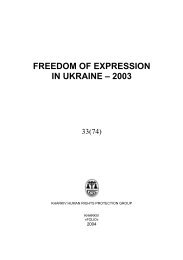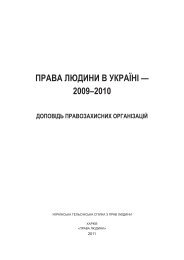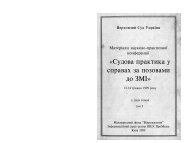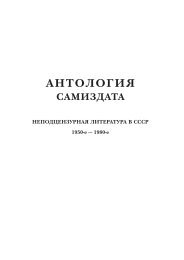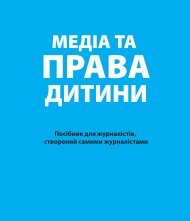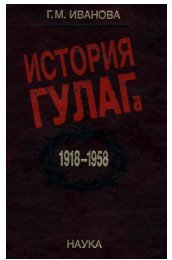- Page 2:
DesignerBoris ZakharovOn the cover
- Page 5 and 6:
Section 5. ANALYSIS OF THE EFFECTIV
- Page 7 and 8:
ForewordThe investigation comprised
- Page 9 and 10:
Methodological framework of the stu
- Page 11 and 12:
Methodological framework of the stu
- Page 13 and 14:
Methodological framework of the stu
- Page 15 and 16:
⇒ 1. Information about the projec
- Page 17 and 18:
Methodological framework of the stu
- Page 19 and 20:
Methodological framework of the stu
- Page 21 and 22:
Methodological framework of the stu
- Page 23 and 24:
Methodological framework of the stu
- Page 25 and 26:
Methodological framework of the stu
- Page 27 and 28:
Methodological framework of the stu
- Page 29 and 30:
Methodological framework of the stu
- Page 31 and 32:
Methodological framework of the stu
- Page 33 and 34:
Section 1Analysis of legislation on
- Page 35 and 36:
Section 1Analysis of legislation on
- Page 37 and 38:
Section 1Analysis of legislation on
- Page 39 and 40:
Section 1Analysis of legislation on
- Page 41 and 42:
Section 1Analysis of legislation on
- Page 43 and 44:
Section 1Analysis of legislation on
- Page 45:
Section 1Analysis of legislation on
- Page 48 and 49:
Torture and ill-treatment of childr
- Page 50 and 51:
Torture and ill-treatment of childr
- Page 52 and 53:
Torture and ill-treatment of childr
- Page 54 and 55:
Torture and ill-treatment of childr
- Page 56 and 57:
Torture and ill-treatment of childr
- Page 58 and 59:
Torture and ill-treatment of childr
- Page 60 and 61:
Torture and ill-treatment of childr
- Page 62 and 63:
Torture and ill-treatment of childr
- Page 64 and 65:
Torture and ill-treatment of childr
- Page 66 and 67:
Torture and ill-treatment of childr
- Page 68 and 69:
Torture and ill-treatment of childr
- Page 70 and 71:
Torture and ill-treatment of childr
- Page 72 and 73:
Torture and ill-treatment of childr
- Page 74 and 75:
Torture and ill-treatment of childr
- Page 76 and 77:
Torture and ill-treatment of childr
- Page 78 and 79:
Torture and ill-treatment of childr
- Page 80 and 81:
Torture and ill-treatment of childr
- Page 82 and 83:
Torture and ill-treatment of childr
- Page 84 and 85:
Torture and ill-treatment of childr
- Page 86 and 87:
Torture and ill-treatment of childr
- Page 88 and 89:
Torture and ill-treatment of childr
- Page 90 and 91:
Torture and ill-treatment of childr
- Page 92 and 93:
Torture and ill-treatment of childr
- Page 94 and 95:
Torture and ill-treatment of childr
- Page 96 and 97:
Torture and ill-treatment of childr
- Page 98 and 99:
Torture and ill-treatment of childr
- Page 100 and 101:
Torture and ill-treatment of childr
- Page 102 and 103:
Torture and ill-treatment of childr
- Page 104 and 105:
Torture and ill-treatment of childr
- Page 106 and 107: Torture and ill-treatment of childr
- Page 108 and 109: Torture and ill-treatment of childr
- Page 110 and 111: Torture and ill-treatment of childr
- Page 112 and 113: Torture and ill-treatment of childr
- Page 114 and 115: Torture and ill-treatment of childr
- Page 116 and 117: Torture and ill-treatment of childr
- Page 118 and 119: Torture and ill-treatment of childr
- Page 120 and 121: Torture and ill-treatment of childr
- Page 122 and 123: Torture and ill-treatment of childr
- Page 124 and 125: Torture and ill-treatment of childr
- Page 126 and 127: Torture and ill-treatment of childr
- Page 128 and 129: Torture and ill-treatment of childr
- Page 130 and 131: Torture and ill-treatment of childr
- Page 132 and 133: Torture and ill-treatment of childr
- Page 134 and 135: Torture and ill-treatment of childr
- Page 136 and 137: Torture and ill-treatment of childr
- Page 138 and 139: Torture and ill-treatment of childr
- Page 140 and 141: Torture and ill-treatment of childr
- Page 142 and 143: Torture and ill-treatment of childr
- Page 144 and 145: Torture and ill-treatment of childr
- Page 146 and 147: Torture and ill-treatment of childr
- Page 148 and 149: Torture and ill-treatment of childr
- Page 150 and 151: Torture and ill-treatment of childr
- Page 152 and 153: Torture and ill-treatment of childr
- Page 154 and 155: Torture and ill-treatment of childr
- Page 158 and 159: Torture and ill-treatment of childr
- Page 160 and 161: Torture and ill-treatment of childr
- Page 162 and 163: Torture and ill-treatment of childr
- Page 164 and 165: Torture and ill-treatment of childr
- Page 166 and 167: Torture and ill-treatment of childr
- Page 168 and 169: Torture and ill-treatment of childr
- Page 170 and 171: Torture and ill-treatment of childr
- Page 172 and 173: Torture and ill-treatment of childr
- Page 174 and 175: Torture and ill-treatment of childr
- Page 176 and 177: Torture and ill-treatment of childr
- Page 178 and 179: Torture and ill-treatment of childr
- Page 180 and 181: Torture and ill-treatment of childr
- Page 182 and 183: Torture and ill-treatment of childr
- Page 184 and 185: Torture and ill-treatment of childr
- Page 186 and 187: Torture and ill-treatment of childr
- Page 188 and 189: Torture and ill-treatment of childr
- Page 190 and 191: Torture and ill-treatment of childr
- Page 192 and 193: Torture and ill-treatment of childr
- Page 194 and 195: Torture and ill-treatment of childr
- Page 196: Науково-практичне



